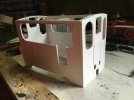viaEstrecha
Spanish metre gauge in G scale (on the cheap)
Bit of a newbie question, but has anyone any tips on cutting an accurate and crisp largish hole in foamboard and styrene sheet? I need to make 4 holes of 15mm diameter for the cab porthole windows on my freelance build, which is a bit limiting as I have only flat blade, auger and masonry drill bits in that size! Oh, and a step drill bit, but not a vertical drillstand or pillar drill. My best idea so far is to make a small pilot hole and attempt to hold the flat bit as steady as possible and hope it does not wander like usual when the bit immediately makes its own large 'pilot' hole, deeper than the plastic sheet.
But I just feel there has to be a better way to go through thin sheet, such as clamping the material between something else and perhaps using another bit more creatively? Any suggestions from skilled scratch-builders, please?
But I just feel there has to be a better way to go through thin sheet, such as clamping the material between something else and perhaps using another bit more creatively? Any suggestions from skilled scratch-builders, please?





